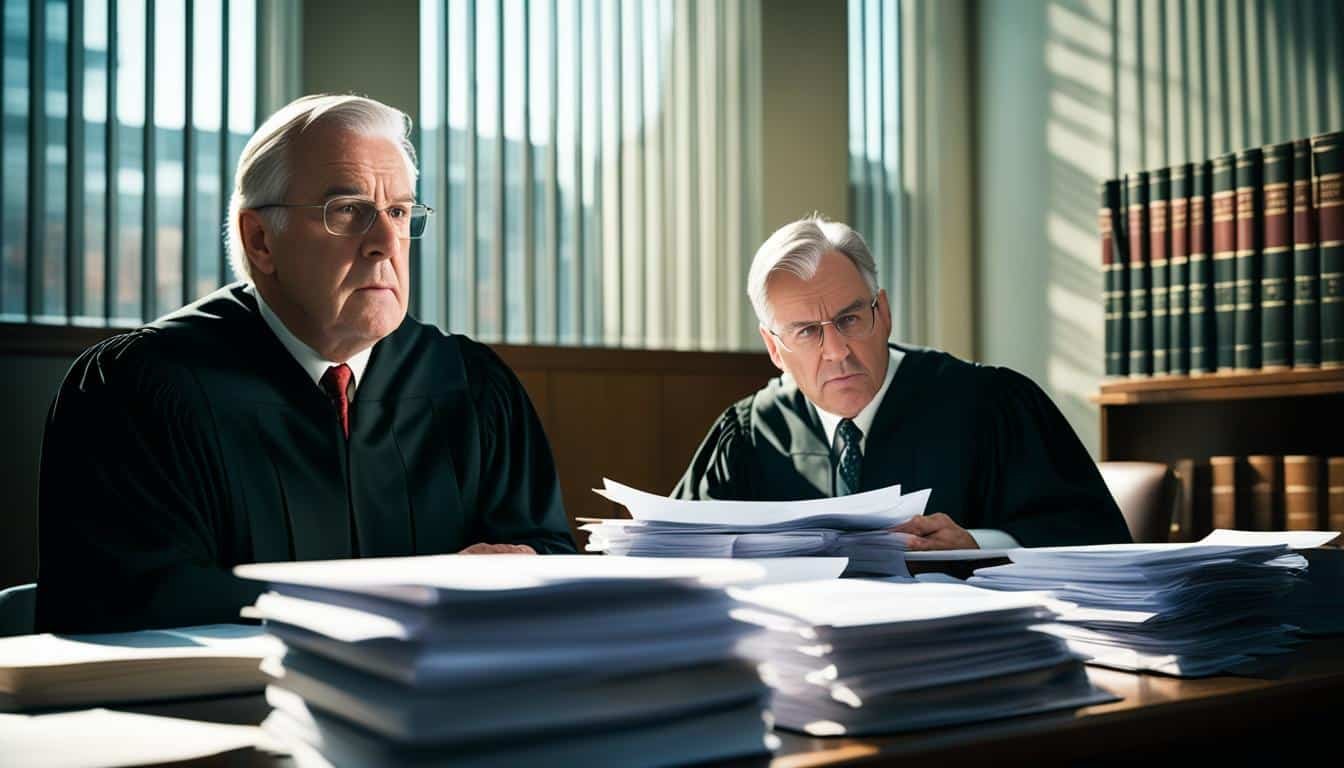Litigation is a formal way to solve legal disagreements. It happens in the civil court system. People can argue about a lot of things, like personal injury claims or breach of contract issues. These cases can be brought to state or federal court.
Also Read: What Are The Key Components Of Effective Career Education Systems?
Each step has rules to follow. These are the rules of civil procedure. When someone joins a litigation case, like as a plaintiff or defendant, having a good attorney by their side is wise.
Key Takeaways
- Litigation is a formal process for resolving legal disputes in the civil court system.
- Litigation can involve a wide range of issues, from personal injury to breach of contract.
- Specific rules of civil procedure govern the litigation process, which can occur in state or federal court.
- Hiring an experienced attorney is generally recommended for individuals involved in litigation as a plaintiff or defendant.
- The litigation process can be complex and time-consuming, often taking years to resolve.
What is Litigation?
Litigation is the way we solve disputes in court. It covers many types of cases including those with personal injury, issues of breach of contract, battles over intellectual property, and class action lawsuits. These issues can be handled in either state or federal courts. Each case follows special rules of civil procedure that lay out the process.
Also Read: Comparative Jurisdiction: How Different Systems Operate
Definition of Litigation
Litigation is how we solve disputes and legal conflicts formally. It uses the civil court system to look into different legal issues and find legal remedies. The litigation process is overseen by judges and sometimes juries.
Purpose of Litigation
The purpose of litigation is to offer a clear way to handle disputes and find justice. It lets plaintiffs seek compensation for damages or injunctive relief to prevent certain actions. Also, defendants can protect themselves against legal claims and avoid liability.
Parties Involved in Litigation
There’s a plaintiff and a defendant in litigation. The plaintiff starts the legal action, while the defendant is the one being sued. They each might have their lawyer who knows about their kind of case.
| Plaintiff | Defendant |
|---|---|
| The individual or entity that initiates the legal action and seeks compensation or relief. | The party being sued, who must respond to the legal claims and defend themselves. |
| May be seeking monetary damages, injunctive relief, or other legal remedies. | Must demonstrate that the plaintiff’s claims are unfounded or that the defendant is not liable. |
| Often represented by a specialized trial lawyer or litigator. | Often represented by a specialized trial lawyer or litigator. |
Along with the plaintiff and defendant, there are also expert witnesses, fact witnesses, and others like judges, juries, and court reporters.
Also Read: The Foundation Of Democracy: Understanding The Constitution
Initiation of a Lawsuit

The start of a lawsuit often begins with the filing of a complaint in a federal court by the plaintiff. This document lists the plaintiff’s complaints and how the defendant caused them. It also asks the court to help by giving legal remedies. After this is done, the plaintiff needs to make sure the defendant gets a copy of the complaint. This is a key step that starts the litigation.
Filing a Complaint
Starting a lawsuit means the plaintiff filing a complaint with the court. They also must serve a copy of this on the defendant. The complaint talks about what the plaintiff is asking for and how the defendant is involved. This includes the jurisdiction of the court. The plaintiff can ask for money or for the defendant to stop causing harm. The court might also give other kinds of help, like saying what the law is in a situation.
Serving the Defendant
After filing, the plaintiff makes sure the defendant gets the complaint. This is called “service,” and it must be done right. It tells the defendant about the lawsuit and makes them respond. There are specific ways to do this according to the rules of civil procedure.
Responding to the Complaint
After getting the complaint, the defendant has to respond in about 21 days. They can answer the complaint directly or challenge the court’s jurisdiction. This response is very important. It marks the beginning of the discovery and pretrial steps in the case.
The Discovery Phase

The discovery process in law is a key step where those involved gather and share case info. It’s crucial for the trial prep. This part requires all parties to bring forth their proof and ready any witnesses.
Also Read: The Process Of Legislation: From Proposal To Law
Interrogatories
Interrogatories are sets of written questions one side poses for the other to answer under oath. These questions can dig into case details, like who saw what, the case’s core arguments, and providing certain documents.
Requests for Production
In requests for production, one party asks for certain papers, emails, and more from the other. This ensures both sides get the whole story. Because having all the facts is important.
Depositions
Depositions are where witnesses are questioned live, under oath. This is usually by the opposing side’s lawyer. It’s a chance to hear their stories up close and personal. This happens before the main trial so lawyers can judge their trustworthiness.
The discovery part is very important in a lawsuit. It allows everyone to look deeply into the facts and get ready for court. Through these steps, they can find important evidence, locate possible witnesses, and build strong plans to settle their differences.
Pretrial Motions and Conferences
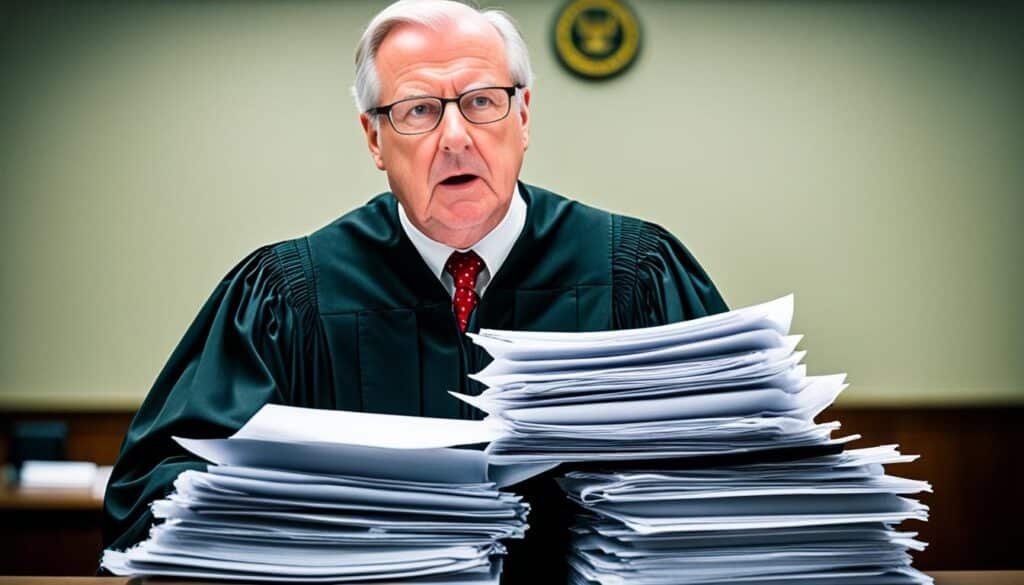
After finding evidence in the discovery phase, the legal process turns to pretrial motions and conferences. These are meant to make the case clearer, focus on what really matters, and possibly wrap up the case without a full trial.
Also Read: The Evolution Of The Legal Profession: A History Of Lawyer
Motions to Dismiss
A motion to dismiss is a frequent early step. Here, a party claims the court can’t handle the case or the complaint doesn’t make a valid legal argument. Even if everything said in the case is true. If the court agrees to a motion to dismiss, the case usually ends. But the person who filed the original complaint might get a chance to fix it.
Summary Judgment Motions
Another key motion is for summary judgment. This motion asks the court to decide if one side wins without needing a trial, based on the facts everyone agrees on. If the court grants summary judgment, the case ends in favor of the party who asked for it. If not, there will be a trial.
Settlement Conferences
Courts may also set up settlement conferences. Here, the parties, along with their lawyers, meet with a judge or a mediator. The goal is to see if they can agree and settle the case without a full trial. These meetings offer a chance for both sides to find common ground or unique solutions that can save time and money.
The Trial Process
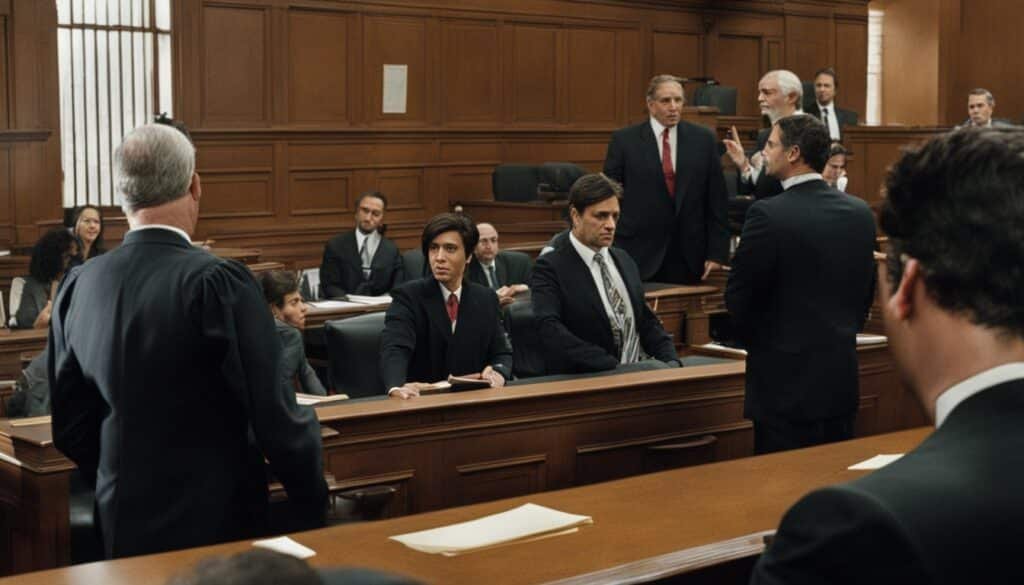
As a litigation attorney or litigator, the trial process is vital. It’s where we present arguments and evidence to the court and jury. The trial starts with opening statements. Each side talks about their case and the main issues to be decided.
Presentation of Evidence
Witnesses and documents are used during the presentation of evidence. The rules of evidence guide what can be said. This helps keep the trial fair. We also keep witnesses apart so they don’t change their story.
Closing Arguments
After presenting evidence, closing arguments happen. Here, the parties sum up their case. They try to convince the judge or jury to support them. What’s said during this part is key to the court’s final choice.
The trial and appeal process is key in solving legal disputes. It shows how the parties can reach their goals. Knowing the trial process well, trial lawyers can guide through the court system. They can work for their client’s goals and client’s business.
Litigation in Federal vs State Courts
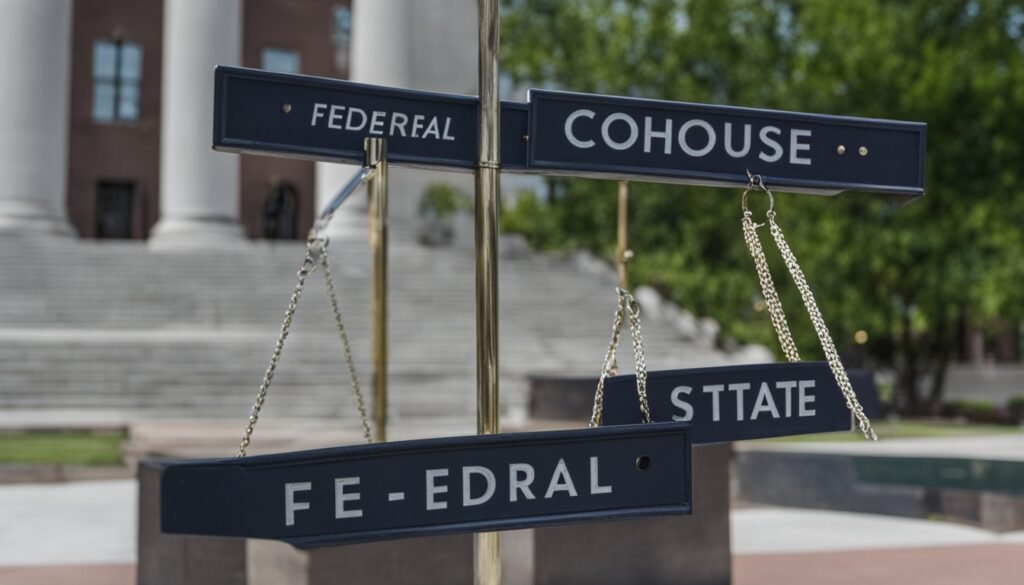
In the United States, folks can take their legal fights to either federal or state courts. This decision touches everything from how the case goes on to where it ends up. It also sets the scene for the litigation process and defines who has power over the legal dispute.
Challenges in federal court deal with laws on a national level. For example, they might look at intellectual property questions, class action lawsuits, or issues with federal agencies like the Federal Trade Commission (FTC). Federal courts step in when those fighting are from different states, and there’s over $75,000 in question. In state courts, it’s more about state laws applied to things like personal injury or breach of contract.
Getting through a federal court case means following the Federal Rules of Civil Procedure. These are different from what you’d see in state courts. These rule differences affect how fast the case moves, what’s needed for discovery, what kind of motion practice is allowed, and the big plan. Lawyers who know federal law well can guide their clients really well along the way.
Choosing federal or state court usually depends on what the case is about. It also considers where the case fits and what the goals are, business-wise or not. Good trial lawyers and litigators can lead plaintiffs and defendants smoothly through the legal maze. Their aim is to get the best legal outcomes.
| Litigation in Federal Court | Litigation in State Court |
|---|---|
| Involves cases arising under federal law, such as intellectual property disputes, class action lawsuits, and matters related to federal agencies like the FTC. | Typically handles cases involving state laws, such as personal injury, breach of contract, and other civil litigation matters. |
| Follows the Federal Rules of Civil Procedure, which can differ from the rules and procedures used in state courts. | Follows the specific rules and procedures set by the state court system, which may vary from federal court requirements. |
| Federal courts have jurisdiction over cases where the parties involved are citizens of different states and the amount in controversy exceeds $75,000. | State courts generally have jurisdiction over cases involving state laws and local matters. |
| Attorneys specializing in federal court litigation often have a deep understanding of the nuances in the federal litigation process. | Attorneys with experience in state court litigation can provide valuable guidance navigating the specific rules and procedures of the state court system. |
Role of the Judge and Jury

In litigation cases, the judge and jury are very important. They help decide what happens in the case. The case might go to a jury for a decision, or just to a judge.
Jury Trials
Most civil lawsuits in the United States are decided by a jury. A jury is a group of citizens. They listen to evidence, hear what both sides say, and then make a decision. The jury decides the facts of the case and follows the law to choose a side.
Bench Trials
Sometimes, the people in the case might not want a jury to decide. They could pick just a judge, which is called a bench trial. In these trials, a judge looks at the facts and the law. Then, they give the final decision. This way is often used in harder cases or when they want more control over the outcome.
Choosing between a jury and a judge doesn’t change how fair the process aims to be. Both the judge and the jury are key to making sure the right thing is done. They help keep the rule of law and make sure everyone’s rights are safe.
Burden of Proof in Litigation
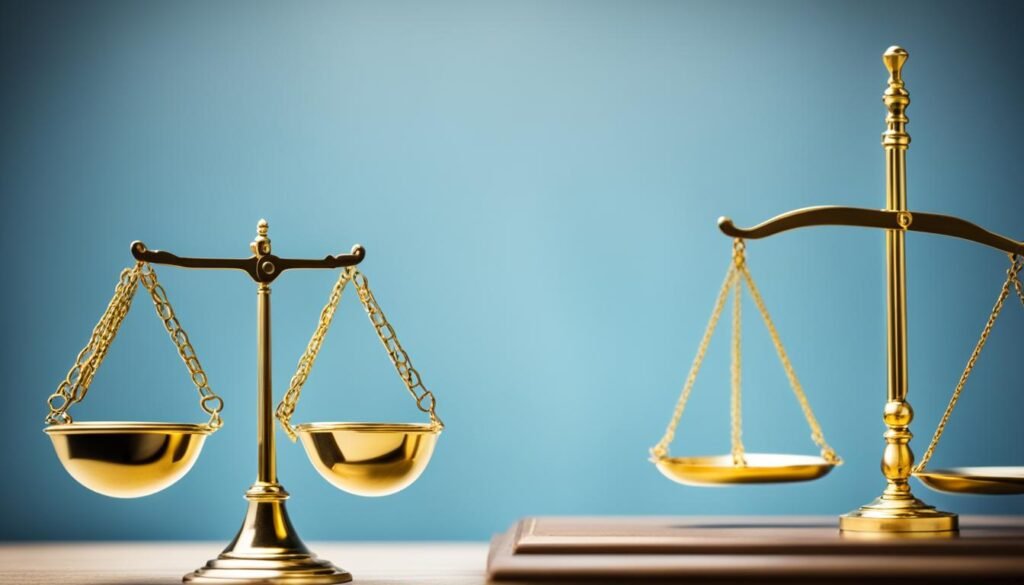
In the world of litigation, the burden of proof decides legal disputes’ outcomes. In a civil case, the plaintiff needs to show the jury by a “preponderance of the evidence” – it’s more likely than not – that the defendant caused the harm. This is easier to prove than the “beyond a reasonable doubt” needed in criminal cases, as the issues are usually about money, not crime.
The burden of proof is key for fairness in the litigation process. It makes it the plaintiff’s job to prove their case, not the defendant’s to show their innocence. This way, both sides’ rights are protected, following the principles of due process and fair trial.
During litigation practice, trial lawyers work hard to meet this burden of proof. They present strong evidence and points to win the judge or jury’s favor. The case’s result often depends on the plaintiff’s skill in showing the defendant’s responsibility, making sure justice is done and everyone’s rights are guarded.
Also Read: What Role Does Corporate Governance Play In Banking And Finance Law?
Litigation Strategies
In litigation, parties use different strategies to win their cases. Settlement negotiations and alternative dispute resolution (ADR) are common tactics.
Settlement Negotiations
Settlement negotiations are key in litigation. Experienced lawyers talk to the other party to find a common ground. They try to agree on things like money or specific actions to avoid going to trial. This helps keep control over the case’s result and saves time and money.
Alternative Dispute Resolution
Parties can also choose ADR over going to court. ADR uses methods like mediation and arbitration. In mediation, a neutral person helps both sides find an agreement. With arbitration, an independent person makes a final decision after hearing both sides. ADR is often quicker and less expensive than court, helping to keep relationships intact.
FAQs
Q: What is litigation?
A: Litigation is the legal process of resolving disputes through the court system.
Q: What types of litigation are there?
A: There are many different types of litigation, including commercial litigation, civil litigation, and criminal litigation.
Q: What is the role of a litigator?
A: A litigator is a lawyer who specializes in representing clients in court proceedings.
Q: Can you explain the litigation process?
A: The litigation process involves various stages from filing a lawsuit to reaching a verdict in court.
Q: What are some examples of types of litigation?
A: Examples of types of litigation include contract disputes, employment disputes, and personal injury lawsuits.
Q: How does litigation benefit clients’ objectives?
A: Litigation helps clients achieve their objectives by resolving legal disputes in their favor.
Q: What is trial practice in the context of litigation?
A: Trial practice refers to the process of presenting cases in court before a judge or jury.
Q: How does litigation involve law firms across the United States?
A: Litigation may involve law firms from different states when cases have a multi-jurisdictional aspect.
Source Links
- https://nwlc.org/wp-content/uploads/2021/11/Civil-Litigation-Fact-Sheet.pdf
- https://www.uscourts.gov/about-federal-courts/types-cases/civil-cases
- https://www.forbes.com/advisor/legal/litigation/
